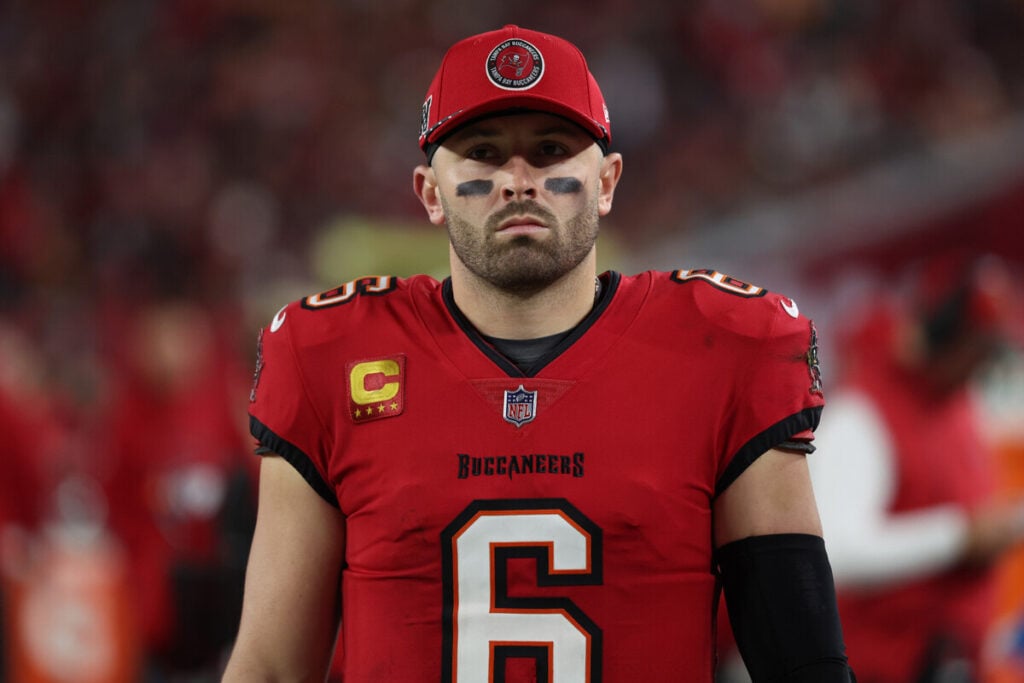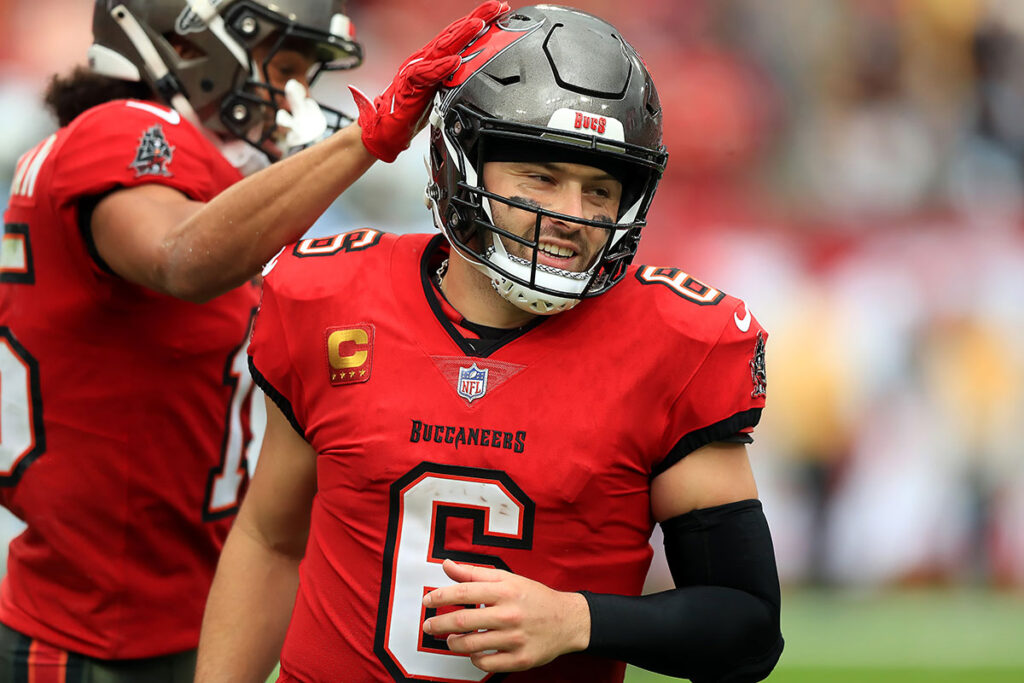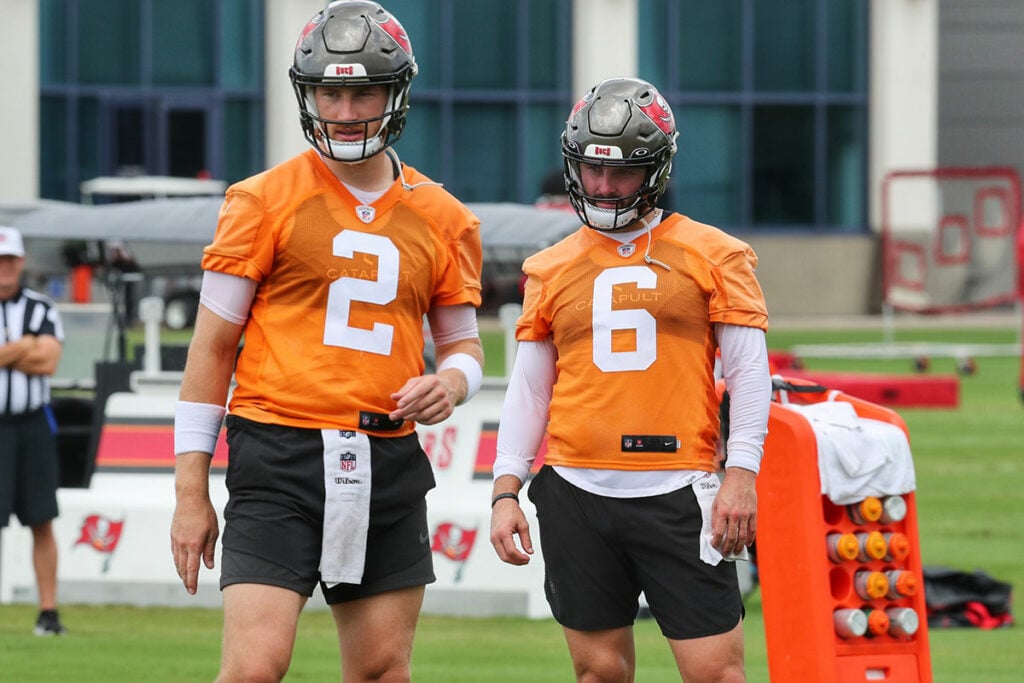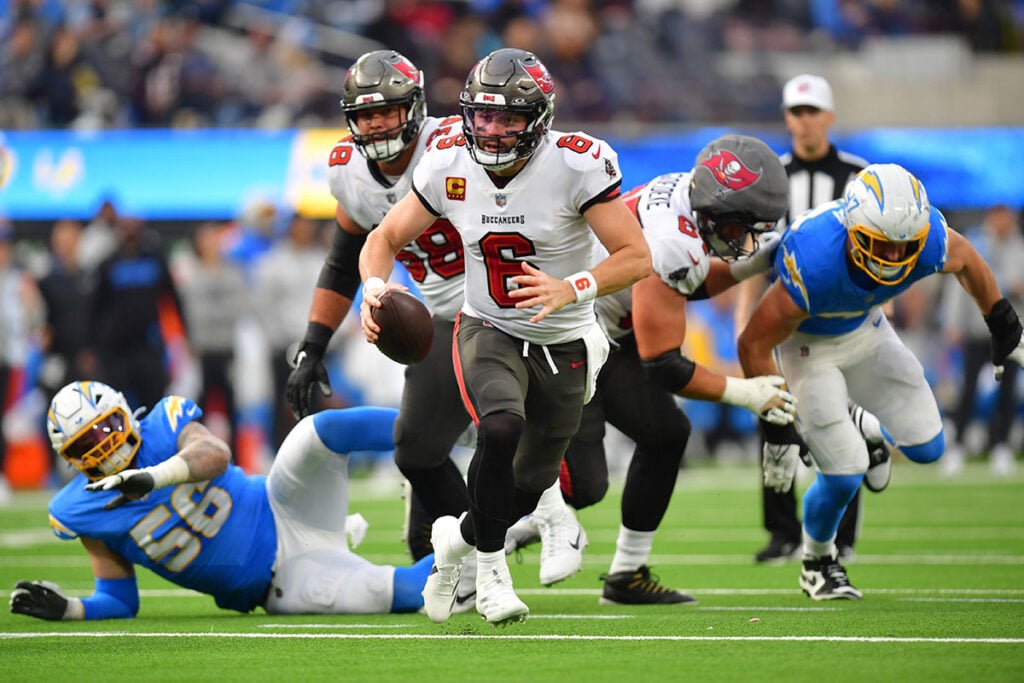Pewter Report’s Bucs Training Camp coverage is presented by USF Football
Get your season tickets to see the Bulls by visiting USFBullsTix.com
The 2025 season kicks off Thursday night, August 28 against Boise State!
The two most heated topics in football may just be quarterback rankings and Pro Football Focus’ grading system. Mention either in a room, or social media feed, full of football fans and be prepared to duck and cover. Both elicit impassioned responses, and it seems no one has a mild opinion on either subject.
Lucky us that William Moy, the head of the grading team at PFF, decided to peel back the curtain to let the masses see how the site comes to their 0-100 grades by using the quarterback position as the example. And because of that, we get to see a deeper look at how Baker Mayfield earned his 85.9 grade last season, which was the sixth-best among quarterbacks.
The Scale
Without getting into too much detail – Moy does that in the article (linked above) – PFF tracks every play for a player on a +2.0 to -2.0 scale by increments of 0.5. Most plays result in a 0.0 grade. That means the player executed their assignment as designed. A play with a positive grade means they went outside of expectations to a degree, while a negative grade means they failed to execute to a degree in some way, shape or form.

Bucs QB Baker Mayfield – Photo by: USA Today
Once all of the individual grades are added up, the site has a formula for translating that raw grade into the scalable grade that is so well known at this point. It wasn’t always this way. In their seminal days, PFF used to produce the raw grades. It was enlightening, as it could show how much impact, positive or negative, a player provided relative to their snap share.
But the public understands and appreciates grades in a Madden-like fashion, so the current leadership of the company, led by NBC analyst Cris Collinsworth, made the decision to change to what we see today. A detailed history of this can be found on the subscription-based site Wide Left, written by one of the greatest voices of our generation, Arif Hasan.
A Baker Mayfield Breakdown
Back to Baker Mayfield. In the article, it shows Mayfield third in the NFL among qualifying quarterbacks in the percentage of plays where he received a positive grade, whether that be +0.5, +1.0, +1.5 or +2.0. His 28.3% was just a tick below Brock Purdy’s 28.4%, and well behind Lamar Jackson’s 30.8%.
When Moy looked at a weighted version of that list, Mayfield fell to 6th at 31.8%, trailing Jackson, Josh Allen, Joe Burrow, Justin Herbert and Jayden Daniels. We can infer that Baker was racking up the +0.5s but trailed the others in the truly outlandish, “HOW DID HE DO THAT?!?!” plays.

Bucs QB Baker Mayfield – Photo by: Cliff Welch/PR
What the article does not revel explicitly is how Mayfield ranked in negative plays. Grades are affected by both the good and the bad, while every quarterback tries to avoid the ugly. But thankfully, the article has a tool to bring up each quarterback’s individual profile. As such, I dug through each gunslinger to see what insights that aren’t normally available can be discerned about the Bucs’ signal caller.
WAR – What is it good for?
Wins Above Replacement, or WAR for short, is a term that is fairly well-known in the sports lexicon. It burst onto the scene as a part of the sabermetrics revolution in baseball in the early aughts and has remained there ever since. Other sports have tried to replicate the process, but none feature the isolation of individual play quite like America’s pastime.
Still, PFF has had their WAR metric around for a few years. They just haven’t made it readily available. WAR essentially attempts to measure how many wins a player adds to their team total over a hypothetical replacement-level player.
Mayfield was credited with 2.9 WAR last year. Another way of thinking about that is if Kyle Trask had been running the offense all season, the team likely would have gone 7-10 instead of 10-7. Mayfield’s 2.9 WAR ranked sixth in the NFL behind Joe Burrow (4.8), Jackson (3.9), Justin Herbert (3.5), Jayden Daniels (3.1) and Geno Smith (3.0),

Bucs QBs Kyle Trask and Baker Mayfield – Photo by: Cliff Welch/PR
This tracks with how well Mayfield ran the offense last year, combined with some of the out-of-structure Houdini magic he was able to pull off at times.
The Impact Of Negative Plays
PFF credited Mayfield with a total of 85 negative plays, an average of five per game. Sixty of those were -0.5, with just 10 at -1.0 and 15 at -1.5. Totaled up, negatives accounted for 12.2% of his total drop backs. Of the 18 quarterbacks with at least 500 pass plays, he ranks almost dead middle in negative play rate at 10th overall.
But when you look at the significantly bad plays, -1.0 or worse, his 3.6% rate is 17th in that group. While I can’t state for sure that my weighting system matches PFF’s, using a weighted ranking of negative play rate would have Mayfield at 9.0% – good for 15th of 18.
And this brings us back to the nature of Mayfield’s play. In many ways, he is a big game hunter. Early in his career, this manifested in his propensity to push the ball deep down field. More recently, it is his out-of-structure play. That play has brought some amazing moments – the Nick Bosa fend off comes to mind – but it has also led to putting the ball in danger.
That is, in part, why he was credited with 24 turnover-worthy plays and part of his 14 fumbles last year as well. It is also borne out by the percentage of his plays that received a ‘zero’ grade. At 59.4%, he was third lowest, bested only by Lamar Jackson and Brock Purdy.
The Gap
Even factoring in some of those danger-inducing decisions, the good far outweighed the bad for Mayfield last year. With a positive differential of +16.1% (5th overall) and a weighted positive differential of +6.9% (7th overall), he easily outpaced most of his contemporaries. It is no wonder that his scaled grade is buttressed by these two rankings.

Bucs QB Baker Mayfield – Photo by: USA Today
PFF grades are by no means the end-all, be-all to player evaluation. I don’t think the company has ever intended for that to be the case. But 99% of the population does not have the time, nor the resources, to objectively watch every snap of every game for every player.
Their army of tape-watchers and cross checkers provide the closest thing the public has to an objective, directional understanding of how players are performing, even if there are still perplexing disconnects still embedded in their model. *Cough, Bucs defensive tackle run defense grades, cough*
Used as a part of larger evaluation models, these grades can be informative. For example, there is a high correlation between these grades and how much players get paid in free agency and contract extensions. I use them in many of my own contract projection models. And now with this new peek into the how and a glimpse at the underlying data, we get a new understanding and appreciation of the awesomeness of Baker Mayfield’s 2024 season.